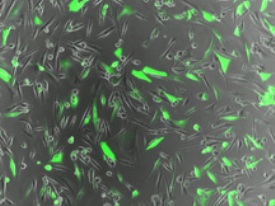A research team from Johns Hopkins University School of Medicine has identified a method that provides gene therapy to cancer cells of the human brain employing nanoparticles.
The nanoparticles used for this purpose are freeze-dried and retained up to a period of three months before use. The shelf-stable particles may prevent the need for virus-induced gene therapy in order to ensure safety.
 Brain cancer cells produce a green fluorescent protein
Brain cancer cells produce a green fluorescent protein
In order to produce the nanoparticle, the team procured small molecules and methodically mixed them in different combinations to initiate chemical reactions that helped to obtain different polymers. Each different polymer was mixed with DNA that encodes a fluorescent protein, thereby making the DNA to attach to the polymers and produce the nanoparticles. They added each different sample to human brain cancer cells as well as to its stem cells. After 2 days, the researchers analyzed and counted the number of cells that glowed by absorbing the nanoparticles and produced the fluorescent protein encoded by the DNAs that were induced into the cell.
The success was determined by counting the number of cells that survived and by finding the percentage of glowing cells. Among the different combinations that were experimented, the researchers identified that poly (beta-amino ester formulation) nanoparticles were quite effective in getting into both brain cancer stem cells and glioblastoma. These nanoparticles were then freeze-dried at three different temperatures such as room, refrigerator, and freezer temperature for three different storage periods such as one, two or three months. The stored nanoparticles were experimented again to test their ability to get into cells.
The team found that the nanoparticles stored for six months showed half the effectiveness of fresh nanoparticles. However, there was no change in effectiveness with nanoparticles stored up to three months at room temperature. Moreover, it was found that few nanoparticles had a particular attraction towards brain cancer cells over healthy brain cells.